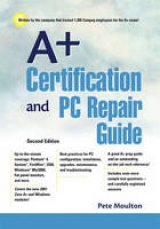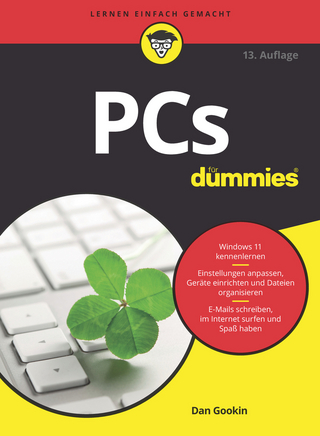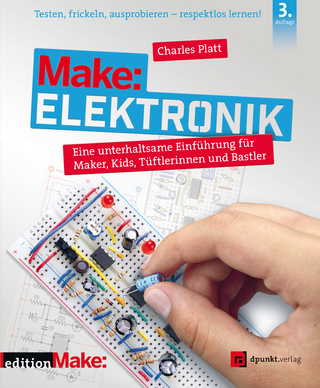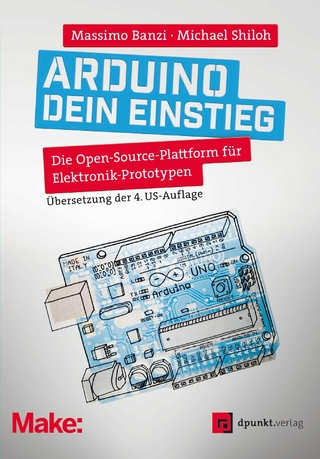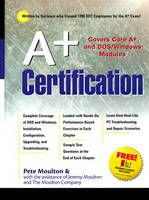
A+ Certification
Prentice Hall (Verlag)
978-0-13-084316-6 (ISBN)
- Titel erscheint in neuer Auflage
- Artikel merken
Master PC troubleshooting and repair, pass the industry-leading A+ certification exam -- and have fun doing it! The authors of A+ Certification aren't just top PC troubleshooters and trainers: they're also co-hosts of the radio show "Dial A Nerd"! This book is full of easy-to-understand photos, real-world anecdotes from the trenches, and A+ sample questions. In short, you get all the rigorous exam preparation you need -- without the pain! You'll start with the basics of configuring, installing and upgrading PCs. Master the basic troubleshooting, maintenance and safety techniques every PC technician should know. Review every important PC component and peripheral covered on the newest A+ exam, including motherboards, CPUs, and memory; printers; network cards; serial and parallel ports; and more. Understand how Windows works; then master every DOS and Windows configuration, integration, networking, and troubleshooting topic covered on the A+ exam. There's also a full chapter on maximizing customer satisfaction -- a crucial element of the latest A+ exam!
For all PC administrative and maintenance personnel responsible for supporting PC users, troubleshooting PC problems, and maintaining and repairing DOS/Windows PCs.
Pete Moulton leads The Moulton Company, a national training company based in Columbia, MD. Recently, The Moulton Company trained 1200 Digital Equipment Corp./Compaq employees for the A+ certification exam. The Moulton Company also produces the weekly radio show "Dial A Nerd," talk radio for the technically challenged, on WJFK-AM in Baltimore (syndicated on the Liberty Works Radio Network).
1. PC Components and Subsystems.
Hardware Components. Main Chassis. Mouse. Keyboard. Video. Printers. Scanners. Video Camera. Microphone and Speakers. Software Components. DOS Components. Windows Components. Windows NT Features and Components. PC Boot Process. The role of CONFIG.SYS. The role of AUTOEXEC.BAT.
2. PC Installation and Upgrade.
PC Component Replacement Summary. Removing and Adding FRUs. Removing the Chassis Cover. The Pin One Rule. Main Logic Board. Disk Drives. Power Supply. CPU Chip. Random Access Memory. Device Controllers and I/O Cards. Common PC Reassembly Mistakes. Hardware Configuration Parameters. Common I/O Port Addresses. Standard IRQ Settings. Upper Memory Used by PC Hardware. PC Direct Memory Access Channels. I/O Cabling and Connectors. Peripheral Port Connector Types and Cabling. Serial versus Parallel Cables. Selected Cable Pin Connections. Installing IDE/EIDE Fixed Disks and CD-ROMs. Master versus Slave Designation. IDE Devices Per Channel. Installing and Configuring SCSI Devices. Bus Termination Basics. SCSI Types. Device Addresses. Cabling. Typical Switches and Jumpers. Installing Common Peripheral Devices. Keyboards and Mice. Video Card and Monitor. Modems. Upgrading Your PC. RAM. Fixed Disk. Display. BIOS Upgrades. CPU. CPU Cache Memory. Troubleshooting and Problem Resolution. Determining the Source of Problems.
3. Troubleshooting PC Hardware.
Power On Self-Test. Audio Beep Error Codes. Video Error Messages. IBM Numeric Error Codes. Diagnosing Error Symptoms and Problems by Subsystem. Power Supply. Main Logic Board. CPU. RAM—Random Access Memory. Video and Monitor. Keyboard and Mouse. Sound Cards. Communications. Slot Covers. Troubleshooting Tools. Troubleshooting Diskettes. Multimeter. Spare Parts or “Swap Until You Drop”. Troubleshooting Procedures and Practices. Problem Isolation and Determination Procedures. User Questions.
4. Maintenance and Safety Practices.
Preventive Maintenance Products and Procedures. Cleaning Compounds. The PC Cleaning Process. PC Power and Other PC Operating Environment Hazards. Power Problems and How to Spot Them. Surge Suppression. Uninterruptible Power Supplies (UPS). Radio Frequency Interference (RFI). Storing Electronic Components. Safety Procedures for High Voltage and Laser Equipment. Laser Safety. High Voltage Components and Safety Procedures. PC Power Supply Safety. Monitor Voltages and Safety. Hazardous Waste Disposal. Batteries. CRTs. Laser Toner Cartridges. Solvents. Other. Electrostatic Discharge (ESD) Procedures. ESD Damage. Protecting from ESD. Common ESD Environments.
5. CPUs, RAM, and Main Logic Boards.
CPU Chips and Their Operating Characteristics. Intel CPU Chips. Other CPU Chips—AMD, Cyrix, Motorola, and Alpha. Random Access Memory. Types of RAM. RAM Operating Characteristics and Parameters. Main Logic Boards. Types of Main Logic Boards. MLB Components. PC Bus Architectures. ISA. EISA. VESA Local Bus or VL-Bus. Micro-Channel Architecture Bus. PCI. Small Form-Factor PCI. Hot-Pluggable PCI. Advanced Graphics Port Bus. PC Card or PC-MCIA Bus. Zoomed Video. USB. IEEE 1394 or FireWire. CMOS Setup. Basic Settings. Advanced Settings. Passwords and Security. Exit.
6. Printers.
Printing Concepts, Components, and Operation. Laser Printers (Page Printers). Inkjet Printers. Dot Matrix Printers. Paper Feeders. Printer Connections and Configurations. Parallel Port. Serial Port. LAN. Infrared Link. Resolving Common Printer Problems. Paper Feed and Output. Paper Jams. Error Indications. Print Quality. Safety Considerations. Printer Servicing and Preventative Maintenance.
7. Laptop PCs.
Laptop Configurations and Components. LCD—Liquid Crystal Display. Battery. AC Adapter. PC Card Bus—Type I, II, and III Cards. CD-ROM Drives. Docking Stations. Fixed Disk Drive. Networking Cards. RAM. Common Laptop Problems. Dropping the Computer. Temperature Extremes. Exposure to X-rays. Unexpected Configuration Problems. Windows Configuration Problems. Power Management Problems. Damage to Connectors. Display Problems. Clocking Problems.
8. LANs and Communications.
LAN Concepts. Data Format Compatibility. Networking Compatibility. Types of Local Area Networks. Network Interface Cards. Network Protocols. Full versus Half Duplex. Network Cabling. Peer-to-Peer versus Client-Server Networks. Windows 3.11. Internet Access. Installing and Configuring Network Interface Cards. Jumpers. Software Setup. Board versus IP Address. Network Problem Manifestations. Reduced Capacity—Bandwidth Loss. Data Loss. Reduced Performance—Slow Networks.
9. DOS Architecture.
DOS Functions. PC System Management. Disk Management. File Management. Managing Applications. DOS Components. Key System Files. IO.SYS. MSDOS.SYS. COMMAND.COM. CONFIG.SYS. AUTOEXEC.BAT. ANSI.SYS. HIMEM.SYS. EMM386.EXE.
10. Windows 3.x Architecture.
Windows 3.x Functions. Managing Applications. Managing Disks and PC Components. Managing Files. Printing. Windows 3.x Components. Driver Programs. Dynamic Link Libraries. The Kernel. GDI.EXE and USER.EXE 527 Resource Heaps. Key Windows 3.x System Files. INI Files. WIN.INI. SYSTEM.INI. USER.EXE. GDI.EXE. WIN.COM. PROGMAN.EXE and PROGMAN.INI. KRNLxxx.EXE. PIF files.
11. Windows 95/98 Architecture.
Windows 3.x versus Windows 95/98. Windows 95/98 Functions. Managing Disks and Files. Managing PC Components. Managing Applications. Managing Printing. Networking. Administrative Functions. Windows 95/98 Components. Device Drivers. Virtual Machine Manager. Installable File System. Windows Core Operating System. Windows 95/98 32-Bit Shell. DLLs. EXEs. The Registry. Windows 95/98 Key System Files. SETUP.EXE. IO.SYS. MSDOS.SYS. COMMAND.COM and TOEXEC.BAT. REGEDIT.EXE. SYSTEM.DAT. USER.DAT. WIN.COM.
12. Disk Navigation Procedures and Management.
File System Basics. Binary versus Text Files. File Naming Conventions. File Attributes. DOS File Operations. Editing TXT and BAT Files. Launching Programs. Windows File Operations. Windows 3.x File Manager. Disk Management Procedures. Partitioning. Formatting. Repairing. Defragmenting. Disk Management Utilities. FDISK. FORMAT. SCANDISK. The FAT System and Directories. DEFRAG. SYS.
13. DOS and Memory Management.
Types of Memory. Conventional. Extended Memory (XMS). High Memory (HIMEM). Upper Memory Blocks (UMBs). Expanded Memory (EMS). Shadow ROM. Virtual Memory. CONFIG.SYS Memory Control Statements 676 Memory Conflicts and Their Resolution. DOS versus Windows Memory Conflicts. General Protection Faults and Illegal Operation Errors. Resolving Windows Problems. System Monitor. System Resource Meter. MEMMAKER. HIMEM.SYS 689 SMARTDRV. EMM386.EXE and Upper Memory Blocks 693 PC DOS Memory Setup.
14. Software Installation, Configuration, and Upgrade.
Operating System Installation Procedures. File Systems. Disk Preparation. DOS Installation. Windows 3.1x Installation. Windows 95/98 Installation. Software Upgrades. System Requirements. General Upgrade Procedure. DOS to Windows 95/98. Windows 3.1x to Windows 95/98. Booting Procedures. Booting DOS. The Windows 3.1x Boot Process. The Windows 95/98 Boot Process. Loading and Adding Device Drivers. Device Drivers and Windows 3.1x. Device Drivers and Windows 95/98. Windows Configuration. Changing Installed Options. Installing and Configuring Printers. Launching Windows Applications.
15. DOS and Windows Software Problem Diagnosis and Resolution.
Common Software Error Messages. Safe Mode. Incorrect DOS Version. Missing Operating System. Error in CONFIG.SYS Line xx. Bad or Missing COMMAND.COM. Bad or Missing HIMEM.SYS. Missing HIMEM.SYS. Swap File Error Messages. Cannot Find a Device File Needed to Run Windows. Resolving Frequent Software Problems. Application Program Errors. System Freezing or Application Programs Hang. Low Resources. Missing Floppy or CD-ROM. Invalid Working Directory. Critical Hardware Errors or the “Option will not function” Message. Application Does Not Load or Start. Cannot Log onto Network. DOS and Windows Utilities. FDISK.EXE—Fixed Disk. SCANDISK—Scan Disk Files and Directories. DEFRAG.EXE—Fixed Disk Defragment. MEM.EXE—Memory Check Program. ATTRIB.EXE—Change Attributes. EXTRACT.EXE—Cabinet File Extraction Tool. EXPAND.EXE—File Expansion Tool. EDIT.COM—The Microsoft Text Editor Program. SYSEDIT.EXE—System Configuration Editor. MSD.EXE—Microsoft Diagnostics Program. The Control Panel—System—Device Manager. MSINFO32.EXE—MS System Information. ERU.EXE—Emergency Recovery Utility. Tweak User Interface—Tweak UI. MKCOMPAT.EXE—Make Compatible Utility. Viruses and Virus Protection. Viruses versus Trojan Horse/Worm programs. Sources of Viruses. Detecting Viruses. Virus Removal Procedure.
16. Windows Networking.
LAN Networking Functions. Disk Sharing. File Sharing. Print Sharing. LAN Types and Cards. Ethernet. Token Ring. ATM. ARCnet. Configuring for Internet Access. Dial-Up Configuration. TCP/IP. The World Wide Web (WWW). Universal Resource Locators (URLs). HyperText Markup Language (HTML). HyperText Transfer Protocol (HTTP). File Transfer Protocol (FTP). Domain Names (Web Site Designations). Internet Service Providers (ISPs). Email.
17. Customer Satisfaction.
Communicating with the Customer. Face-to-Face. Telephone Communications. Understanding Customer Problem Descriptions. Verbal and Nonverbal Cues. Helping with Problem Identification. Communicating at the Appropriate Technical Level. Establishing Customer Rapport. Professional Conduct. Punctuality. Avoiding Conflicts. Responding to and Closing Service Calls. Handling Customer Complaints. Empathy for Customer Problems. Sense of Urgency. Flexibility.
18.Y2K and Other PC Tales.
PCs and Y2K. BIOS Compatibility. Operating System Compatibility. Applications Compatibility. General Y2K Protection. Other PC Tales. Tools in a Pinch. What Happens When?
Index.
| Erscheint lt. Verlag | 10.11.1999 |
|---|---|
| Verlagsort | Upper Saddle River |
| Sprache | englisch |
| Maße | 187 x 242 mm |
| Gewicht | 2086 g |
| Themenwelt | Mathematik / Informatik ► Informatik ► Theorie / Studium |
| Informatik ► Weitere Themen ► Hardware | |
| Informatik ► Weitere Themen ► Zertifizierung | |
| ISBN-10 | 0-13-084316-4 / 0130843164 |
| ISBN-13 | 978-0-13-084316-6 / 9780130843166 |
| Zustand | Neuware |
| Haben Sie eine Frage zum Produkt? |
aus dem Bereich
